At home with Xavier Veilhan
In our ongoing profile series, we find out what artists are making, what’s making them tick, and the moments that made them. Xavier Veilhan tells us about his new show at Perrotin New York, the oddities of NFTs, and the role of public (or not-so-public) sculpture
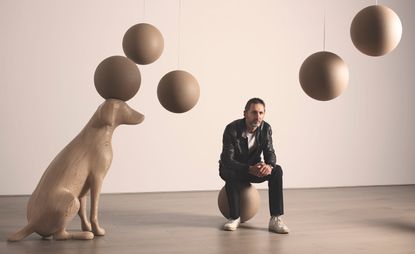
‘Multi-faceted’ is a term frequently used to describe artists’ work. For Xavier Veilhan, the term is literal and figurative.
Through installation, sculpture, painting and photography, and often combinations of these, The French artist dissects perception in its many forms to pose a fundamental question: what makes us human?
At Perrotin New York, Veilhan is blurring boundaries with a new series of sculptures for ‘Autofocus’ (a play on ‘out of focus’) in which the sharpness of figures and forms is softened to a spectral haze. Details are dissolved, but body language, familiarity and human character remain intact.
Wallpaper*: Hi Xavier, how are you?
Xavier Veilhan: I’m OK! I was running around Paris a few minutes before the call. I made a stop at Christo and Jeanne-Claude’s L'Arc de Triomphe, Wrapped. It was impressive and poetic at the same time.
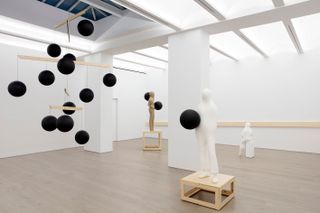
Exhibition View of Xavier Veilhan: 'Autofocus' at Perrotin New York, 2021.
W*: Where are you now?
XV: I’m in an office which we use for Zooms. It’s the opposite of my studio space, which is 240 sq m of open space. This room was thought up by the architect as a recording studio, that's why the walls are made of plywood. It’s similar to the music studio I made for the Venice Biennale. I sometimes listen to music here and have old 1970s speakers which are super high quality.
The studio had to be an open space. The quality of communication with my team is very important to me. So no endless meetings, not too much data, but a lot of speaking.
The winners of the Pritzker Architecture Prize this year, Anne Lacaton and Jean-Philippe Vassal, are building a new studio and house for me in the countryside, one hour east of Paris. It’s not that I will stop working in this studio, but it’s another studio. It’s a high-rise building but in the middle of nature.
Wallpaper* Newsletter
Receive our daily digest of inspiration, escapism and design stories from around the world direct to your inbox
W*: Can you talk a little about your new show at Perrotin New York?
XV: The show’s title is ‘Autofocus’, which sounds a little bit like ‘out of focus’. It’s about very simple statues representing human figures.
You will know the faceted shapes [in my work], but these shapes I call ‘blur’ sculptures. Usually, when something is seen as a blur, it’s because there is something wrong in the vision or perception. But these works are blurred even if seen with sharp eyes.
I’m still interested in the same idea, which is feeling the physical presence of somebody without looking at them, but it’s expressed through different means.
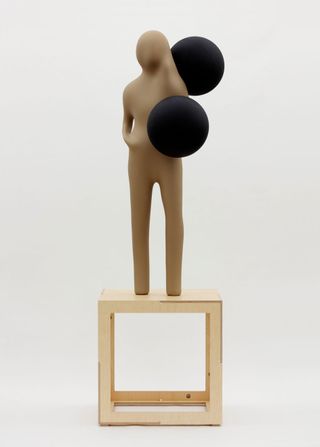
Xavier Veilhan, Violeta, 2021.
W*: Can you describe the maquette you’re holding?
XV: This is a girl with a strange bump which is a tote bag. We start from a very accurate [3D] scanner and process [the image] through different layers of filters until the character has almost disappeared, erased; until there is only a ghostly presence.
W*: What material are the sculptures created in?
XV: It’s a new kind of concrete under patent, made with recycled materials like stone dust. Almost two years ago, we decided to consider the environment as a primary issue. It’s not perfect, but we try to reduce our use of resins and plastics.
W*: What does this new material offer you; what makes it versatile?
XV: It’s more organic and replaces polyester resin. It’s still very slick and soft, and it’s hollow so it’s not that heavy. It can go outside, which is always a concern for me because I install many pieces outdoors.
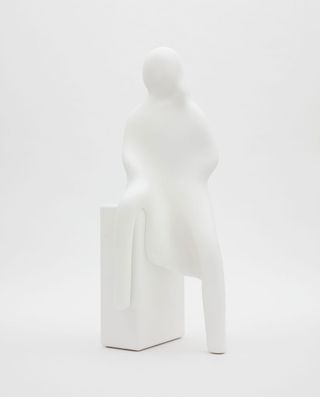
Xavier Veilhan, Violeta n°1, 2021. Composite mineral mortar, polyurethane varnish.
W*: Did you begin by photographing figures for the statues?
XV: We use a 3D scanner. We’ve used it for about 15 years, which is interesting because of the change in complexity. For example, it was demanding when we first started because people had to pose for 45 minutes to one hour, and now it’s only ten minutes.
I’m interested in the process. Not only because it’s a new technology, but because it makes visible that the model is involved in the process. It’s not a stolen image, paparazzi style. It’s more collaborative between the model and the artist.
W*: So the idea is to capture the body language of the person. And how do you select the models?
XV: Yes, exactly. [The models are] people you establish a relationship with, but it’s not a friendship, it’s not love or a physical relationship. It’s something in between that. You have empathy with the way they are because you get used to them. I try to catch this feeling, this familiarity with what people are.
Your friend would recognise you from afar, not because of the detail of your clothes, but because of the position of your body. This is something we have a special sense of, like we have a sense of danger.
W*: You’ve previously collaborated with notable figures, like Daft Punk in 2015. The way they present themselves – most notably with their helmets – is very familiar to us, but the people under the helmets are less familiar. In a sense, your sculpture unmasked them.
XV: The funny thing about Daft Punk is I invited them as music producers, so the title of the work is Thomas Bangalter & Guy-Manuel de Homem-Christo. Because they are here represented as producers, they are themselves, and asked not to wear the masks because they wanted to appear in a normal way; not as performers, but as music workers.
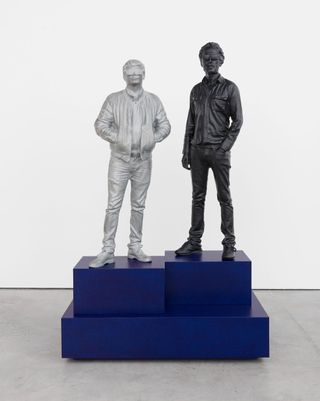
Xavier Veilhan, Thomas Bangalter & Guy-Manuel de Homem-Christo, 2015. Aluminium-filled polyurethane resin, black resin, plywood, acrylic paint, varnish.
W*: Many of your sculptures have been installed in public spaces. What do you find so fascinating about the public engaging with your work?
XV: What I'm most interested in about public art is that it’s not public most of the time. It seems to be in the public area, and accessible to the public, but it’s in the centre of major cities, and most of the projects are by private invitation, and funded by private money or are privatised public spaces that are re-offered to the public.
In the public space, people pass by, they don’t have time and their vision is not focused on what you’re doing. Your work is one part of a bigger landscape. It’s more like a car that’s been designed by a team; you don’t really care who designed the car. This means that whether it’s a totally unknown artist, or Anish Kapoor, it’s the same.
And then there’s also the public presence of who we earlier considered heroes, but were people who promoted colonialism or racism. It’s now a question about whether we should dismantle the statues, or preserve them with an explanation. These are good questions to ask, but I don’t have the answer. So what I try to do is work on representation and focus on people that I admire, like Daft Punk and Lee Scratch Perry.
W*: How would you say your approach and priorities have evolved since the beginning of your career?
XV: On one hand, I'm inside an economy and I’m looking towards certain success, but I also want to keep it small. As Thomas Hirschhorn once said, ‘Energy: Yes! Quality: No!’ I could say, ‘Intensity: Yes! Quantity: No!’

Exhibition View of Xavier Veilhan: 'Autofocus' at Perrotin New York, 2021
W*: So you’re concerned if things got too big you would lose intensity?
XV: Getting older, I’m more into emotions and feelings. For example, I realised that my memory is very bad, so memories of visual experiences are not very important to me, it’s more the emotion, and sometimes emotion appears by surprise.
In 30 years of work, the main thing [that’s changed] has been the digital era. I had a studio with no computer, it had a fax machine and an answering machine.
I am very scared about the manipulation of information, and how you can verify information. But the digital era changed so many things in a good way, geolocalisation for example. I’m almost 60, and my generation is characterised by having one foot in digital and one foot in non-digital.
W*: Aside from the scary side of the digital world, like misinformation, are you open to new technologies?
XV: As my friend Rob Pruitt says, ‘If it’s new, it’s good.’ It’s fresh and bold to say that. But that is not a moral, it’s just exciting. It means when something is new, it carries something dynamic and positive, and I think like that. I’m very bad with technology, but when I don't know how to do something, I ask the right person.


Top: The dude, 2020. Above: Score, 2020, by Xavier Veilhan. Ink on paper, plywood frame.
W*: What has been your most challenging project to date?
XV: The biggest difficulty is finding the money and time to develop ideas. As you described earlier, you have to give shape to something, to take an idea that doesn’t occupy any space and load it with materiality. It has to fit like a missing piece of the puzzle in reality. It’s interesting to see how some things don’t last because they don’t fit.
W*: Do you have a particular work in mind?
XV: Not of mine, but I’m interested in NFTs for example: most are super boring, ugly, and the quality of pieces is bad. The only reason why the chain of value is activated is that there is suddenly a way to originate data.
W*: So it’s not really about the work, it’s about ownership over something that we previously thought couldn’t be owned.
That’s very interesting. Because the value is not the image, the value is ownership. It’s the quality of the ownership, which is paid for, not the object.
W*: Perhaps you’re paying for a certificate you can show off.
XV: It’s like a vaccine passport!
It’s like, ‘What?! Somebody paid all this money for this terrible picture?’ But for me, it underlines not that bitcoin is abstract, but that our system is super abstract because we give value to pieces of paper.

Xavier Veilhan, Le Mobile n°2, 2021, Composite mineral mortar, polyester resin, fiberglass, Birch plywood, stainless steel, cotton
W*: Going back to your Perrotin show, it’s physical, but the works are blurred. So I suppose it does occupy this space between real and unreal. This is a place we have all become very familiar with in recent history, viewing much of life via screens.
XV: Well, listening to what you’re saying, I realise that the interest in those blurred sculptures is maybe because they include qualities that are normally linked to images, not objects. For example, when I showed you the sculpture [maquette]. You saw a picture, but I had the object in my hand.
W*: What you saw was 3D, what I saw was 2D.
XV: Yes, and we are talking about three-dimensional images, but what is interesting is that 3D images don’t exist. Images are only 2D. If it’s not an image, it can get a third dimension, but that is space.
The pandemic represented an invasion of 2D, because we have been looking at screens more and more: Netflix, Instagram, Zoom.
W*: So, because of the restrictions, you will be hanging your show over Zoom, in 2D?
XV: I did that for the piece I did for the Olympics, and another piece in Tokyo which was public (but once again, private!), but open-air, and for a solo show in Perrotin in Tokyo; I have to recognise that it doesn’t affect much of the quality. It’s not obligatory to be there from my point of view. But this one will only be accessible in person in New York.

Xavier Veilhan, The Audience (2021), installed at the Olympic Agora, during the Tokyo 2020 Olympic Games
INFORMATION
Xavier Veilhan: ’Autofocus’, until 23 December 2021, Perrotin New York, perrotin.com
Harriet Lloyd-Smith was the Arts Editor of Wallpaper*, responsible for the art pages across digital and print, including profiles, exhibition reviews, and contemporary art collaborations. She started at Wallpaper* in 2017 and has written for leading contemporary art publications, auction houses and arts charities, and lectured on review writing and art journalism. When she’s not writing about art, she’s making her own.
-
 First look at Samba Room, London’s innovative cocktail lounge packed with Brazilian energy
First look at Samba Room, London’s innovative cocktail lounge packed with Brazilian energyLondon’s Samba Room, an extension of SushiSamba, is a dynamic bar, lounge and private dining space designed by Fabled Studio
By Tianna Williams Published
-
 Thom Browne shows how to make the perfect bed with theatrical performance at Milan Design Week 2024
Thom Browne shows how to make the perfect bed with theatrical performance at Milan Design Week 2024American fashion designer Thom Browne makes his Milan Design Week debut with a new homeware collection created in collaboration with historic linen company Frette
By Scarlett Conlon Published
-
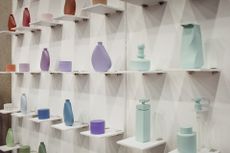 Cosmoprof 2024: the beauty innovations discovered by Wallpaper*
Cosmoprof 2024: the beauty innovations discovered by Wallpaper*Cosmoprof invited Wallpaper* to discover the latest innovations in beauty, from tech devices to natural skincare
By Hannah Tindle Published
-
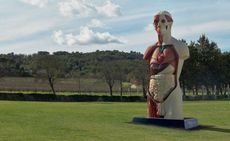 Damien Hirst takes over Château La Coste
Damien Hirst takes over Château La CosteDamien Hirst’s ‘The Light That Shines’ at Château La Coste includes new and existing work, and takes over the entire 500-acre estate in Provence
By Hannah Silver Published
-
 Peter Blake’s sculptures spark joy at Waddington Custot in London
Peter Blake’s sculptures spark joy at Waddington Custot in London‘Peter Blake: Sculpture and Other Matters’, at London's Waddington Custot, spans six decades of the artist's career
By Hannah Silver Published
-
 Oozing, squidgy, erupting forms come alive at Hayward Gallery
Oozing, squidgy, erupting forms come alive at Hayward Gallery‘When Forms Come Alive: Sixty Years of Restless Sculpture’ at Hayward Gallery, London, is a group show full of twists and turns
By Hannah Silver Published
-
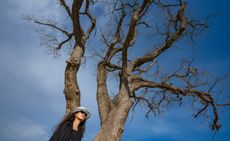 Tia-Thuy Nguyen encases Chateau La Coste oak tree in tonne of stainless steel strips
Tia-Thuy Nguyen encases Chateau La Coste oak tree in tonne of stainless steel stripsTia-Thuy Nguyen’s ‘Flower of Life’ lives in the grounds of sculpture park and organic winery Château La Coste in France
By Harriet Quick Published
-
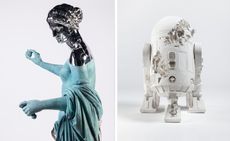 Daniel Arsham debuts new work in Paris and New York
Daniel Arsham debuts new work in Paris and New YorkDaniel Arsham and Perrotin mark 20 years of collaboration with New York and Paris exhibitions
By Hannah Silver Published
-
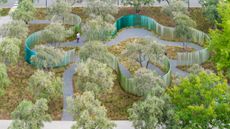 New glass sculpture creates a verdant wonderland at Apple’s Cupertino HQ
New glass sculpture creates a verdant wonderland at Apple’s Cupertino HQ‘Mirage’ at Apple Park is the work of Zeller & Moye and artist Katie Paterson, a shimmering array of glass columns that snakes through the grounds of the company’s monumental HQ
By Jonathan Bell Published
-
 Man Ray’s sculptures go on show in New York
Man Ray’s sculptures go on show in New York‘Man Ray: Other Objects’ opens at Luxembourg + Co, New York, revealing their author’s ‘artistic revolution’
By Hannah Silver Published
-
 The best London art exhibitions to see now
The best London art exhibitions to see nowYour guide to the best London art exhibitions, as chosen by the Wallpaper* arts desk
By Hannah Silver Published